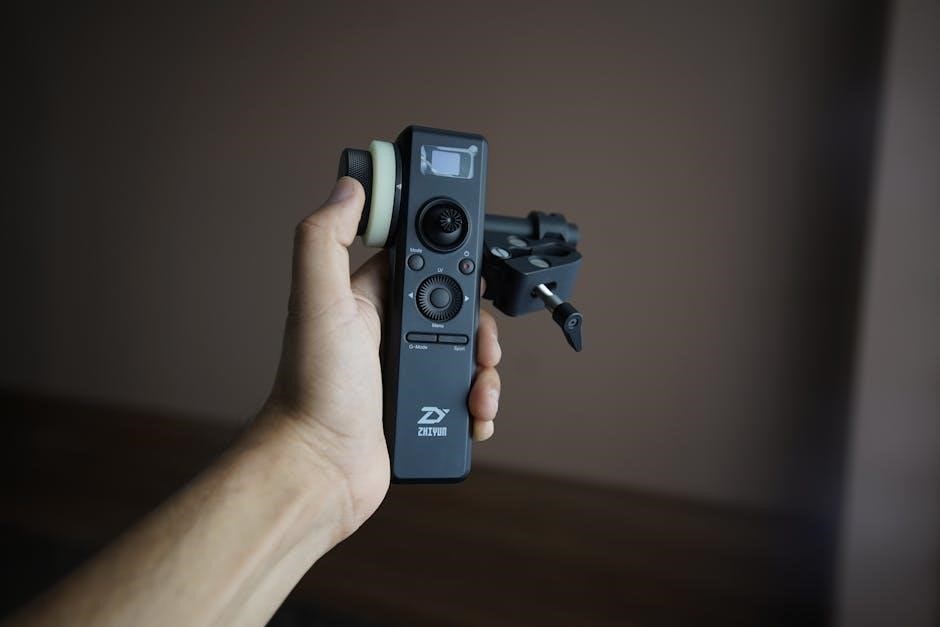
solar charge controller user manual pdf
Welcome to the world of solar charge controllers! This document will guide you through understanding these devices‚ crucial for efficient solar energy systems․ These controllers regulate the power flow‚ optimizing battery charging and system performance․
What is a Solar Charge Controller?
A solar charge controller‚ also known as a solar regulator‚ is an essential component in most solar power systems that use batteries․ Its primary function is to regulate the voltage and current coming from the solar panels to prevent overcharging of the batteries․ Overcharging can significantly reduce battery life and potentially cause damage or even hazardous situations․
The controller acts as a safeguard‚ ensuring that the batteries are charged in a safe and efficient manner․ It achieves this by monitoring the battery’s voltage and adjusting the charging process accordingly․ Different types of controllers‚ such as PWM and MPPT‚ employ various techniques to optimize the charging process․ Ultimately‚ the solar charge controller plays a vital role in maintaining the health and longevity of the batteries‚ maximizing the overall performance and lifespan of the solar power system․
Why is a User Manual Important?
The user manual is your comprehensive guide to understanding and effectively utilizing your solar charge controller․ It contains crucial information regarding the safe installation‚ operation‚ and maintenance of the device․ Neglecting the user manual can lead to improper setup‚ potentially damaging the controller‚ batteries‚ or other components of your solar power system․
This manual provides step-by-step instructions‚ safety precautions‚ and troubleshooting tips‚ enabling you to optimize your system’s performance and extend its lifespan․ Furthermore‚ the manual outlines specific features‚ settings‚ and advanced functionalities of your controller‚ empowering you to customize the system to meet your specific energy needs․ By carefully reading and understanding the user manual‚ you can ensure a safe‚ efficient‚ and long-lasting solar power solution․ It contains information about Battery Life algorithm․

Key Features and Functions
Delve into the core functionalities of your solar charge controller․ Discover the essential features that optimize performance‚ protect your system‚ and maximize energy harvesting from your solar panels․
MPPT vs․ PWM Charge Controllers
Understanding the difference between MPPT (Maximum Power Point Tracking) and PWM (Pulse Width Modulation) charge controllers is crucial for selecting the right one for your solar system․ PWM controllers are the simpler and more affordable option‚ essentially acting as a switch between the solar panel and the battery․ They’re best suited for smaller systems where the solar panel voltage closely matches the battery voltage․
MPPT controllers‚ on the other hand‚ are more sophisticated․ They actively seek the maximum power point of the solar panel‚ converting excess voltage into amperage for more efficient charging․ This is particularly beneficial in larger systems or when using high-voltage solar panels with lower-voltage batteries․ MPPT controllers can significantly increase energy harvest‚ especially in suboptimal conditions․ Choosing between MPPT and PWM depends on your system size‚ budget‚ and desired efficiency․
Battery Compatibility and Settings
Solar charge controllers are designed to work with various battery types‚ including lead-acid (open‚ sealed‚ gel) and lithium-ion batteries․ Ensuring compatibility between your charge controller and battery is paramount for safe and efficient operation․ Different battery types require specific charging voltages and algorithms․ Incorrect settings can lead to undercharging‚ overcharging‚ or even battery damage․
Refer to your battery manufacturer’s specifications for recommended charging parameters․ Most charge controllers offer adjustable settings to accommodate different battery types․ These settings often include voltage levels for bulk‚ absorption‚ and float charging stages․ Some controllers also feature temperature compensation‚ which adjusts charging voltage based on battery temperature․ Always verify and configure these settings correctly before connecting your battery to the charge controller to maximize battery life and performance․

Installation Guide
This section provides a step-by-step guide for installing your solar charge controller․ Proper installation is crucial for safety and optimal performance․ Follow these instructions carefully to ensure a successful setup․
Wiring Connections: PV Array‚ Battery‚ and Load
Establishing the correct wiring connections between your PV array‚ battery‚ and load is paramount for the safe and efficient operation of your solar power system․ Always disconnect all power sources before commencing any wiring work․ Refer to the wiring diagram specific to your charge controller model for accurate guidance․
First‚ connect the battery to the charge controller‚ ensuring correct polarity (positive to positive‚ negative to negative)․ Next‚ connect the PV array‚ again observing polarity․ Finally‚ connect the load‚ if applicable‚ paying close attention to its voltage and current requirements․
Use appropriately sized wiring to handle the expected current․ Secure all connections tightly to prevent arcing or overheating․ Double-check all polarities before energizing the system․ Incorrect wiring can damage the controller‚ battery‚ and other components․
Consult a qualified electrician if you are unsure about any aspect of the wiring process․ Safety is always the top priority․
Safety Precautions and Considerations
Prioritizing safety is crucial when installing and operating any solar power system component‚ including the charge controller․ Always disconnect all power sources before performing any maintenance or adjustments․ Ensure the charge controller is installed in a well-ventilated area‚ away from flammable materials‚ and protected from moisture and extreme temperatures․
Never exceed the charge controller’s voltage or current ratings‚ as this can lead to damage or fire․ Use appropriately sized fuses or circuit breakers to protect the system from overloads and short circuits․ Regularly inspect wiring for signs of wear or damage‚ and replace any faulty components immediately․
When working with batteries‚ exercise caution as they contain corrosive materials and can release explosive gases․ Wear appropriate personal protective equipment‚ such as safety glasses and gloves․ Always follow the battery manufacturer’s instructions for handling and maintenance․
If you are not comfortable working with electrical systems‚ consult a qualified electrician․ Improper installation or maintenance can pose a significant safety risk․

Operation and Monitoring
Effective operation and monitoring are essential for maximizing the performance and lifespan of your solar charge controller and battery system․ This section provides guidance on understanding the display‚ indicators‚ and troubleshooting․
Understanding the Display and Indicators
Your solar charge controller features a display and indicators providing real-time system status․ The display typically shows voltage‚ current‚ battery state of charge‚ and error codes․ Familiarize yourself with these parameters for optimal system management․
LED indicators often signal charging status‚ battery health‚ and potential faults․ A solid green light might indicate normal charging‚ while a flashing red light could signal an overvoltage or low voltage condition․ Consult this manual for specific meanings of each indicator․
Regularly monitoring these indicators allows for proactive identification and resolution of issues‚ ensuring efficient energy harvesting and preventing battery damage․ Understanding these visual cues is crucial for maintaining a healthy and productive solar power system; Consistent observation enables informed decisions about load management and system adjustments․
Troubleshooting Common Issues
Encountering issues with your solar charge controller is normal․ This section addresses common problems and their solutions․ If your battery isn’t charging‚ check the PV array voltage and wiring connections․ Ensure the solar panels are receiving adequate sunlight․
Overcharging can damage batteries․ Verify the charge controller’s settings match your battery type and voltage․ If the load is disconnecting frequently‚ it could be due to low battery voltage․ Reduce the load or increase solar input․
Error codes on the display provide valuable diagnostic information․ Consult this manual for specific error code definitions and troubleshooting steps․ Always disconnect power before inspecting wiring․ If problems persist‚ contact a qualified technician․ Proper diagnosis and prompt action are key to resolving issues and maintaining a functional solar system․

Advanced Settings and Customization
Unlock your controller’s full potential! This section explores advanced settings for fine-tuning performance․ Adjust parameters to optimize battery life and system efficiency․ Customize settings to meet your specific energy needs․
Battery Life Algorithm and Optimization
Maximize your battery lifespan with intelligent algorithms! The BatteryLife algorithm monitors your battery’s state of charge‚ adapting charging cycles for optimal health․ By analyzing usage patterns‚ the controller dynamically adjusts settings to prevent overcharging and deep discharging‚ two major causes of premature battery failure․
The algorithm increases equalization intervals when needed‚ ensuring all cells within the battery bank are balanced․ This prevents sulfation‚ a common issue in lead-acid batteries․ User customization allows tailoring the algorithm to specific battery types and environmental conditions․
Optimize your battery’s performance by enabling features like temperature compensation‚ adjusting charging voltage based on ambient temperature․ Fine-tune these settings for extended battery life and reliable power․
Adjusting Voltage and Current Parameters
Fine-tune your solar charge controller with adjustable voltage and current parameters for optimized charging․ Access these settings to customize charging profiles based on your specific battery type and system requirements․ Adjust bulk‚ absorption‚ and float voltage levels to match your battery manufacturer’s recommendations․
Setting the appropriate charging current limits prevents overcharging and protects your batteries from damage․ Monitor the charge current and voltage readings on the display to ensure parameters are within safe ranges․ Advanced users can configure custom charging profiles for specialized battery chemistries or unique system configurations․
Utilize these advanced settings to maximize battery life and system efficiency․ Incorrect voltage and current settings can significantly reduce battery lifespan‚ so consult your battery documentation for proper values․